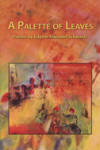A Palette of Leaves
Edythe Haendel Schwartz skillfully employs ekphrastic poetry in her second collection, A Palette of Leaves. Through describing and responding to artists and their art—conception, process, and result—Haendel Schwartz focuses on the interplay of art forms in the face of tragedy, emphasizing a need for the written and the visual to interact. Divided into three substantial sections, the collection reads as events always in the middle of an action, adhering to process and memory rather than finality. While the mostly narrative forms vary from neatly organized, consistent lines to ones swaying across the page, these poems remain closely tied to the tangible things held onto through life.
Edythe Haendel Schwartz skillfully employs ekphrastic poetry in her second collection, A Palette of Leaves. Through describing and responding to artists and their art—conception, process, and result—Haendel Schwartz focuses on the interplay of art forms in the face of tragedy, emphasizing a need for the written and the visual to interact. Divided into three substantial sections, the collection reads as events always in the middle of an action, adhering to process and memory rather than finality. While the mostly narrative forms vary from neatly organized, consistent lines to ones swaying across the page, these poems remain closely tied to the tangible things held onto through life.
Ekphrases continue to appear by holding the collection’s wide breadth of poems together. In “Release,” the speaker describes how, in Kiefer’s painting Fitzcarraldo (2010), “she stares at faults not hers / the woods before her riven by roots / studded as hobnail boots.” This kind of gritty language continues to take shape in “Edward Weston’s Pepper,” where
He set her upright
her cap lit
in grisaille, his eye
pressed to her skin like a palm
against each cell
While “Release” details a woman’s gaze, the latter poem is directly engaged with the male gaze. Providing what are almost interludes from the collection’s broader narrative, these ekphrastic poems still continue to relate back to the dynamics of family relations.
The vast majority of the poems in A Palette of Leaves deals with the loss of the speaker’s mother in the wake of illness by centering on domestic tasks to tell the narrative of mother and daughter. In “Apricot Crisp,” the speaker thinks of her mother baking:
Alone, she listens to her breathing
stumble over tumors,
layers crescent moons of apricots,
flutes the crust.
The mother figure is “Now only a blank nod—her hands clock / hours in pockets of her painter’s smock” with “hues that would document the last // hand she could lift against the growing black” in “Hands.” The speaker likens a woman “In Edward Hopper’s Western Motel . . .” to her mother, “her hand-drawn generations / of drosophila wing mutations, hidden,” who the speaker sees “slicing hearts of romaine to calm / the arugula, eyes longer / to dissect again.” The action of a body in motion juxtaposed against the physical body and mind in decline resonates with the high emotional tenor of these poems.
Laying foundations by rendering remembrance as an art object itself with the fluidity of language, Haendel Schwartz succeeds in stirring up and recreating these moments for the reader. With a painstaking attention to detail, the poems in A Palette of Leaves use the particular to construct a living memory.





